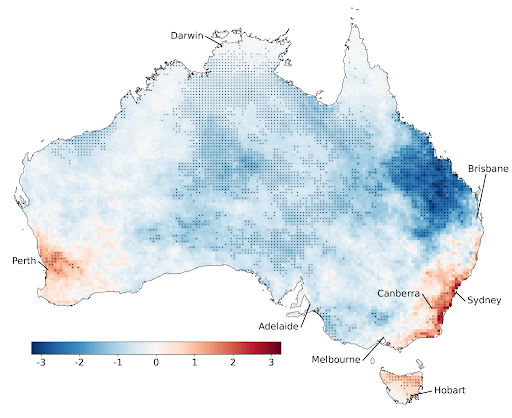Dr Tim Raupach and Alice Wilson

The yearly number of days prone to hailstone formation has increased by up to 40% around Sydney and Perth, and decreased across most other parts of Australia over the past four decades, finds research at the ARC Centre of Excellence for Climate Extremes. This was found in the first Australia-wide study of hail trends.
Information on how hail risk is changing is highly sought after, particularly for insurance companies and farmers, who have experienced first hand the damaging impacts of hail on crops and communities. A recent report by the Insurance Council of Australia found that when adjusted to 2023 dollars, Sydney’s 1999 hailstorm caused $8.85 billion in insured losses, surpassing the cost of the recent 2022 South-East Queensland and New South Wales floods, estimated at $6 billion.
Lead researcher and hail expert Dr Tim Raupach explains that hail is one of the most costly weather extremes in Australia.
“It’s possible for a single hail event to cause over $1 billion in damages, and so industries like agriculture, insurance and urban planning are eager to know how hail has been changing, and which areas of Australia are at higher risk for hail events”.
Until this research, published in npj Climate and Atmospheric Science, our understanding of changing hail trends was limited to a few regional studies in the southeast of Australia.
This is because hail is tricky to observe and study, meaning there is a lot of uncertainty around hail risk in different parts of Australia and across the globe.
“The uncertainty is driven by limited observations of past hail events, and by hailstorms being relatively small in scale, making them hard to study and easy for sensors to miss” says Dr Raupach.
“We do have some idea of how we expect hail to change in a warming climate, however we also know that it’s complicated, with lots of regional differences,” explained Dr Raupach. “We wanted to examine recent regional changes in this work.”
The study was undertaken by Dr Tim Raupach and Professor Steven Sherwood (ARC Centre of Excellence for Climate Extremes and the Climate Change Research Centre) and colleagues Dr Joshua Soderholm and Dr Robert Warren (Bureau of Meteorology).
Drawing on research methods developed in Dr Raupach’s previous work, the researchers studied changes in the occurrence of atmospheric conditions known to lead to hail over 1979 to 2021 across Australia.

“We know there are particular atmospheric ingredients that are needed to produce hail, and so looking at how these ingredients have changed over time can indicate how the hail hazard has changed” says Dr Raupach.
These changes in the atmosphere are easier to study than hail itself. The team checked the results against weather radar data which are generally available around cities. Although the radar data cover a shorter time period, they agreed with the broad pattern of results.
The results show that hail-prone days have decreased across a lot of the country. However in some densely populated regions, including around Sydney and Perth, hail-prone days have increased by up to about 40%.
“Over a lot of places, hail-prone days have decreased, but in some places they have significantly increased. The impacts are going to be very regionally dependent” says Dr Raupach.
The main driver of the changes was found to be changes in the “atmospheric instability”, which is one of the atmospheric ingredients required for hailstorms to form. Atmospheric instability causes the atmosphere to be more prone to forming updrafts that form thunderstorms and hailstorms.
Importantly, this study maps out changes in hail hazard across the entirety of Australia and points towards the regions where hail hazard has been increasing.
Dr Raupach warns however that “although this is the trend we’ve observed in the past 40 years, that doesn’t necessarily mean that it’s going to be the same trend moving forward”.
The next step is better understanding future trends in hail, the topic of Dr Raupach’s next work. This involves further developing our knowledge of the processes causing hail and improving the capability of climate models to simulate these processes.
You can read the full research article online in npj Climate and Atmospheric Science.
